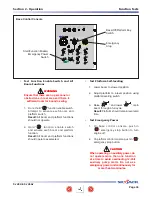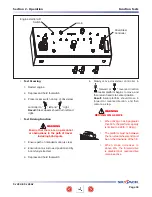
SJ 46A & SJ 46AJ
December 2007
Page 49
TM
Section 2 - Operation
Refueling Procedure
2.11 Refueling Procedure
This section provides the operator with the procedure
on how to refuel the engine with regular fuel and install
the propane cylinder.
impORTANT
Before using the aerial platform ensure
there is enough fuel to finish the job.
wARNiNG
Follow all local and national regulations
for propane handling.
wARNiNG
Failure to heed the following safety
precautions could result in death or
serious injury:
Use extreme caution while refueling
•
aerial platforms.
Ensure engine and all systems are
•
turned off before refueling.
Refuel aerial platform only in a well
•
ventilated area away from open
flame and other sources of ignition,
authorized by your employer and
supervisor.
Liquid propane gas fuel is a gas
•
that is heavier than air. It settles in
low spots. Any flame or spark could
cause a fire that could cause serious
injury.
When changing liquid propane gas
•
cylinder, check all connections for
damage or missing parts. Never try
to start an aerial platform if you smell
gas.
For gasoline engine models, use only
•
unleaded gasoline with an octane
rating 87 or higher.
wARNiNG
Do not smoke in an area where aerial
platforms are stored or refueled.
2.11-1 Regular Fuel
Ensure engine and all systems are turned off and
1.
emergency stop buttons are depressed.
Open fuel compartment door and remove fuel
2.
cap.
Carefully pour fuel into tank ensuring that no
3.
spillage occurs.
Securely replace fuel cap.
4.
Ensure there are no leaks in the fuel system.
5.
Wipe up any spilled fuel.
6.
Dispose of rags in an approved container.
7.
Protection of Environment from Chemical
Dangers
wARNiNG
Gasoline, diesel fuel, engine oil and
hydraulic fluid are chemicals, which can
contaminate the environment. If they
are spilled during filling and reach the
water, they can cause damage to the
environment, e.g., death of fish. For
such damage, the party responsible is
liable! Therefore, gasoline, diesel fuel,
engine oil or hydraulic fluid must not get
into the sewage system, streams, rivers
or other surface water. For that reason,
immediately remove the dripped off or
spilled gasoline, diesel fuel, engine oil
or hydraulic fluid with appropriate means
and dispose of these means according to
the regulations.



































